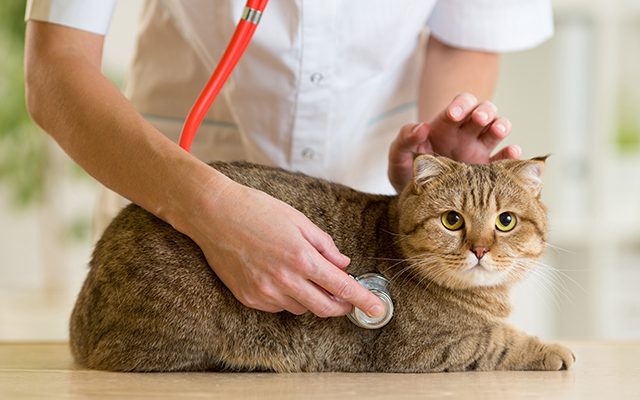
Bisadu waxay leedahay kansar: wax kasta oo aad u baahan tahay inaad ka ogaato cudurkan xayawaanka rabaayada ah
Unfortunately, cancer in cats is considered a fairly common disease and in recent years its cases have increased significantly.
This is partly because cats now live longer. Many veterinarians examine two or even three cats over the age of 15 every day. It is the result of excellent home care, cutting-edge nutritional research and modern veterinary medicine. Everything about the signs that you should pay attention to, and how to provide the cat with the most effective oncological care, if necessary, is in this article.
Contents
Cancer detection in cats

Contrary to popular belief, not every strange mass, growth, or tumor in a cat is cancer.
Cancer is best defined as a disease caused by the uncontrolled division of abnormal cells. The disease can originate in a specific body tissue and, in some cases, spread to other organs as it spreads, usually through the circulatory and lymphatic systems. Veterinarians call this process metastasis. For example, cells dividing in a tumor in a cat’s ear can travel through the bloodstream to her liver.
The most common types of tumors in cats
As with humans, cancer in cats is often hereditary, so it is more common in certain genetic lines. This means that some breeds of cats may be more prone to developing this disease. This also means that certain types of cancer are more common in pets than in humans. The most common types of cancer in cats are:
- Lymphoma The Cornell Feline Health Center notes that this is perhaps the most common malignancy in cats and is often associated with the feline leukemia virus.
- Kansarka unugyada squamous. In the mouth, it is usually aggressive, destructive, and painful, according to the Cornell Cat Health Center, but lesions do not spread in most cases. The cutaneous form is localized similarly and primarily affects the skin of the nose and tips of the ears. Squamous cell carcinoma in cats is closely related to UV exposure.
- Fibrosarcoma, or soft tissue sarcoma. This type of tumor forms in cats in muscle or connective tissue. It can appear anywhere in the cat’s body.
- Tumors of the mammary glands, or breast cancer in a cat. The Cornell Cat Health Center notes that they are considered relatively common in intact cats, but are very rare in pre-puberty spayed cats.
Rare types of tumors in cats
- Kansarka maqaarka it is rare in the cat, but because it tends to grow aggressively, the most suspicious skin tumors should be removed.
- Kansarka sanbabada in cats, it most often occurs when other types of cancer spread through the blood and lymphatic system to the lobes of the lungs.
- Burooyinka maskaxda of the brain can occur when the disease metastasizes from other organs, but can also form directly in the brain.
- Tumors of the nosetend to form in the nose and can be very aggressive.
- As the first focus burooyinka beerka make up a small percentage of all tumors that form in cats, but metastases often appear in the liver.
Calaamadaha Kansarka ee Bisadaha
Unfortunately, cancer in cats, like many other feline diseases, is difficult to detect. Like its wild ancestors, the cat knows how to hide discomfort. Indeed, in the wild, a sick cat is more likely to become a victim.
Signs of cancer in cats are also not always obvious in most cases. Except for obvious bumps and other superficial lesions, they are usually nonspecific and similar to other types of internal disease. The most common signs of cancer in cats are:
- Miisaan lumis. Weight loss, despite no obvious change in appetite, is one of the most common signs that cat owners should look out for.
- Cunto xumo. Any change in appetite is a wake-up call that requires an immediate visit to the veterinarian.
- Changes in eating style. Messing up after eating or chewing on only one side can be a sign of oral swelling, but it can also be a sign of dental disease.
- Daallan. A sick cat usually moves less and hides more.
- Bumps, indurations and skin lesions. These signs are the most obvious, but not the most common.
- matag iyo shuban. Cancer in cats often affects the digestive system.
- Neefsashada ayaa isbedeleysa. Any changes in breathing should be cause for concern. Some cancers can lead to a buildup of fluid in or around the lungs or associated inflammation.
If the cat has any of these signs, you should immediately take it to a veterinarian.
Cancer Treatment in Cats
Modern veterinary medicine has made the treatment of cancer in cats more effective and humane than ever before. Treatment protocols targeted at these sensitive animals are being improved every day. Treatment is carried out at home, but usually at least part of the treatment of the cat takes place in a veterinary clinic.
Superficial tumors in cats—for example, squamous cell carcinoma of the skin and mouth, soft tissue sarcoma, and breast tumors—are often treated with surgery. But chemotherapy may also be required.
Although it sounds intimidating, chemotherapy in cats is different from chemotherapy in humans. Its goal is cancer remission without compromising the furry friend’s quality of life. If at any time the cat becomes uncomfortable as a result of the therapy—usually injections—the treatment can be discontinued. Radiation therapy is also possible, but is less common in cats.
The goal of any cancer treatment, regardless of the type of tumor in a cat, is to improve the patient’s quality of life. If a pet is diagnosed with cancer, a veterinarian will offer the most effective course of treatment and help put your pet back on the path to well-being





